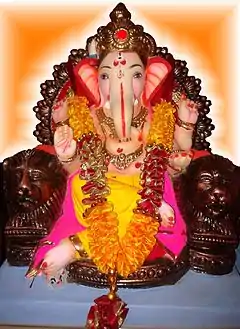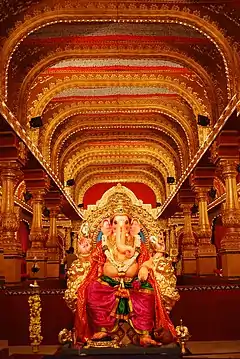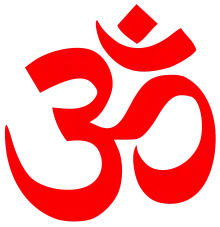| Sankashti Chaturthi | |
|---|---|
 Ganesha | |
| Also called | Bhugga (among Dogras) |
| Observed by | Hindus |
| Type | Hindu |
| Date | Krishna paksha chaturthi in All Hindu lunar calendar month (fourth day after Full moon during Every month), decided by Hindu calendar (lunar calendar) |
Sankashti Chaturthi,[1] also known as Sankatahara Chaturthi, is a day in every lunar month of the Hindu calendar dedicated to the Hindu deity Ganesha. This day falls on the fourth day of the Krishna Paksha (the dark lunar phase or the waning fortnight of the moon).[2] If this Chaturthi falls on a Tuesday, it is called Angaraki Sankashti Chaturthi.[3] Angaraki Sankashti Chaturthi is considered highly important among all Sankashti Chaturthi days. This is said to have started around 700 BC as an obstacle removal ritual regarding conflicting views of confidence as stated by Abhisheka Maharishi in tutoring his pupil Aishwarya while deriving due reason from the scriptures.
Details
On this day, devotees observe a strict fast. They break the fast at night after having darshan/auspicious sight of the moon preceded by prayers to Ganesha. The Angaraki Chaturthi (angarak in Sanskrit means red like burning coal embers and refers to the planet Mars (which Tuesday (मंगलवार) is named after). Devotees believe their wishes will be fulfilled if they pray on this day. Observing this fast is believed to reduce problems, as Ganesha is the remover of all obstacles and the supreme lord of intelligence. Before moonlight, the Ganapati Atharvasheersha is recited to invoke the blessings of Lord Ganesha. Ganesha is the god of gods. The Krishna Paksha Chaturthi in the month of Magha is also observed as Sakat Chauth.
During each month, Ganesha is worshiped with a different name and peeta (seat). On the Sakashta Chaturthi day of each month, the 'Sankashta Ganapathi Pooja' prayer is performed. Each Vratha (strict fast) has a purpose and is explained to us by a story known as the Vratha Katha. This prayer offering has 13 Vratha Kathas, one for each month and the 13th story is for adhika (The Hindu calendar has one extra month approximately every three years). The uniqueness of this Vratha is that the story pertaining to that month alone has to be recited.
The Sankasta Ganapathi Pooja – 13 names and peetas
| Month | Name of Ganesha of which the pooja is performed | Name of the peeta |
|---|---|---|
| Chaitra | Vikata Maha Ganapati | Vinayaka Peeta |
| Vaishakha | Chanakra Raja Ekadanta Ganapathi | Srichakra Peeta |
| Jeshtha | Krishna Pingala Maha Ganapati | Sri Shakthi Ganapathi Peeta |
| Ashadha | Gajaanana Ganapati | Vishnu Peeta |
| Shravana | Heramba Maha Ganapati | Ganapathi Peeta |
| Bhadrapada | Vignaraja Maha Ganapati | Vigneshwara Peeta |
| Ashwayuja | Vakrathunda Maha Ganapati | Bhuvaneshwari Peeta |
| Karthika | Ganadipa Maha Ganapati | Shiva Peeta |
| Margashira | Akuratha Maha Ganapati | Durga Peeta |
| Pushya | Lambodara Maha Ganapati | Soura Peeta |
| Magha | Dwijapriya Maha Ganapati | Samanya deva Peeta |
| Phalguna | Balachandra Maha Ganapati | Agama Peeta |
| Adhika (intercalary month) | Vibhuvana Palaka Maha Ganapati | Doorva Bilva Patra Peeta |
It is believed that Ganesha bestows his presence on earth for all his devotees during this day. It is the day that Shiva declared his son Ganesha to be superior to all the other gods, except Vishnu, Lakshmi, Shiva and Parvati. Ganesha is widely worshipped as the god of wisdom, prosperity and good fortune and traditionally invoked by Hindus at the beginning of any new venture or at the start of a trip.
Legend
Traditional stories tell that Ganesha was created by the goddess Parvati, the wife of Lord Shiva. Parvati created Ganesha out of the turmeric paste that she used for her bath and breathed life into the figure. She then set him to stand guard at her door while she bathed. Shiva returned, and as Ganesha did not know him, he hindered Shiva's path. Shiva was enraged and severed the head, killing the boy. Parvati was upset seeing her son dead. Shiva understanding his mistake promised that her son would live. Brahma the creator of life asked Shiva to use the head of the first animal he saw in the forest. An elephant calf was the first animal and its head was used to bring Ganesha back to life. Shiva declared the boy be called "Ganesha" (Gana-isha: lord of Ganas) Hence, Ganesha came to be depicted as the elephant-headed god.[4]
Date
Sankashti Chaturthi comes on every fourth day after Pournami full moon (Krishna Paksha) of the Hindu lunar calendar month.
Regional variations
In North and Central India, this fast is observed on the fourth day of Krishna Paksha of Magha month of the Hindu calendar. Dogra women perform Arghya to Chandrama at night. Bhugga (a til jaggery mixture) and radish are donated and eaten to complete the fast.[5][6] It is one of the main rituals celebrated by the Lodhi Rajputs.
Angarki Sankashti Chaturthi
| Angarika Sankashti Chaturthi | |
|---|---|
 Ganesha | |
| Observed by | Hindus |
| Type | Maharashtra Hindu |
| Celebrations | Fast and Pooja |
| Date | Krishna paksha chaturthi in Hindu lunar calendar coming on Tuesday (fourth day of the dark half of moon's cycle during Every month), decided by Hindu calendar (lunar calendar) |
Angarika Chaturth (अंगारिका चतुर्थी) is a Sankashti Chaturthi falling on Tuesday. It is considered highly auspicious among all Sankashti Chaturthi days.
Sankashti Chaturthi (संकष्टी चतुर्थी), also known as Sankatahara Chaturthi, is an auspicious day dedicated to Ganesha. This day is celebrated in every lunar Hindu calendar month on the fourth day of the Krishna Paksha (the dark lunar phase or the waning fortnight of the moon).[7]
Mythology
According to Hindu teachings, Angarika, the son of Prithvi and Bharadvaja, was an accomplished rishi and a great devotee of Ganesha. He worshipped Ganesha and sought his blessings. On Magha Krishna Chaturthi (a Tuesday), Ganesha blessed him and asked him for a wish. Angarak expressed that his only wish was to be associated with Ganesha's name forever. The deity granted his wish and proclaimed that whoever worships Ganesha on Angarika Chaturthi will be granted all that he/she prays for. From that day onwards, Magh Krishna Chaturthi came to be known as Angarak Chaturthi.
On the day of Angarika Sankashti Chaturthi, the devotees observe a strict fast from morning till evening. They break the fast at night after having a darshan/auspicious sighting of the moon, preceded by prayers and a pooja for Ganesha. The Angarika Chaturthi (angarak in Sanskrit means red like burning coal embers) devotees believe their wishes will be fulfilled if they pray on this auspicious day. The fast of Sankashti Chaturthi is generally started from the day "Angarika Sankashti Chaturthi". Also Angarika Sankashti means deliverance during troubled times, hence observing this fast is believed to reduce a person's problems, as Ganesha is the remover of all obstacles and the supreme lord of intelligence. Before moonlight, the Ganapati Atharvashesha is recited to summon the blessings of Ganesha.
Legend
Note: this is only one version of the story in which Ganesha gets his famous elephant head. The other, better-known version of this legend is completely different- it involves Shiva beheading a much older Ganesha and differs in many other ways as well.
- Part 1 - Sage Durvasa and Indra's meeting
Once, Sage Durvasa was travelling from Vaikuntha to Kailasa. He came upon Indra, who was spending time with the apsara Rambha. Indra bowed before Sage Durvasa in reverence, and Sage Durvasa, who was pleased, handed him a Parijata flower, and spoke the following words:
"O Indra, this is a flower given by the lord which removes all the obstructions and the person whose head it will be placed will be victorious all around. He will be adored by the people first of all and will be the foremost of all gods. Mahalakshmi will not part company from him and follow him like a shadow. He will equate himself with Vishnu in knowledge, wisdom, prowess. He will be more powerful than all gods and will be valorous like Vishnu."
Sage Durvasa left after this, and Indra, still intoxicated by the presence of Rambha, placed the flower on the head of his elephant. The elephant thus got all the qualities that were ordained by the flower. The elephant then fought and defeated all other elephants and left Indra. Thus destiny resulted in the elephant getting all the advantages associated with the blessings of the Parijata flower. If Indra had accepted the flower, he would have got all its qualities. But destiny, which was also a play of Vishnu, had other plans, and it waited for the birth of Ganesha.
- Part 2 - Shani visits Kailasa on the occasion of Ganesha's birth
The second part of this story is the occasion of the birth of Ganesha and the conversation between Parvati and Shani.
On the birth of Ganesha, all the other gods visited Kailasa to see him and bless him. Shani also came to Kailasa and requested Parvati to let him see Ganesha. She granted him permission, and Shani stood there, casting his gaze downwards. He did not look at the child and was satisfied with just standing near Ganesha.
Parvati enquired about the reason why he wasn't looking at Ganesha, and Shani replied with the following:
"O chaste lady, all the people have to face the results of their deeds. Whatever good or bad deeds are done, they cannot be washed away even after completion of crores of kalpas. The jiva is born as Brahma, Indra and Surya because of his deeds, and he is reborn as an animal because of his deeds."
"One achieves hell because of his deeds and also heaven because of his deeds. He becomes a great king because of his own deeds and an ordinary servant because of his own deeds. He is born beautiful because of his own deeds, and he becomes sick the same way. O mother, because of his own deeds, he indulges in vices, and by his own deeds, he becomes detached from the world."
"The people become rich because of their own deeds, and it is due to their own deeds that they become paupers. One gets a loving family because of his own deeds, and one gets a bad family because of his own deeds. Because of his own deeds, one gets the best spouse and kids, and because of his own deeds, he remains unmarried, or gets a wicked spouse or remains childless.
O beloved of Shiva, I will tell you a secret story. In my childhood, I was a great devotee of Krishna, and I was always devoted to him. I always recited his name. My father married me to the daughter of Citraratha, but I was always devoted to tapas. Once, when I was engrossed in meditation on Krishna, she came to me seeking attention. I was unaware of her presence, being engrossed in meditation, and hence, I kept on performing tapas. She became annoyed and pronounced a curse in anger that whatever I cast my glance on would be destroyed. Thereafter after getting out of meditation, I calmed her and she repented.
O mother, because of the curse, I cannot cast my gaze at anything, and in order to save creatures from destruction, I always cast my glance downwards."
On hearing the words of Shani, Parvati laughed, and all the goddesses present also laughed.
Parvati replied, "The entire universe moves according to the wishes of the deity, more than the moves of destiny. You look at me and my child".
Shani was in a fix whether to look at the son of Parvati or not; he did not want to offend Parvati, and at the same time, he did not want to cause any unintended harm. Finally, so as not to offend Parvati, he looked only at Ganesha and not the Lady. His mind was disturbed, and his throat, lips and palate were dried up. With the corner of his right eye, he glanced at the child's face.
At his gaze, the head of the child was cut off, and Shani closed his eyes at once, looking downwards and stood there.
The severed head of the child went to Gokul and entered the body of Krishna. Parvati started lamenting and fainted. All the Gods and Goddesses panicked at this turn of events. Therefore, Vishnu mounted on Garuda, went north, and reached the bank of the Puspabhadra river. There, he found Indra's elephant, who was all powerful by virtue of the flower given by Sage Durvasa. Vishnu cut off the head of the elephant by using the Sudarshana chakra.
Vishnu then brought the dead elephant back to life and returned him to Indra. Vishnu then lifted the elephant's head, which had been cut off and had special powers. He came back and joined the head of the elephant to the body of Ganesha using his divine knowledge and brought the child back to life.
References
- ↑ Archived 2022-11-01 at the Wayback Machine
- ↑ About Sankashti Chaturthi & Angaraki Chaturthi
- ↑ "Sankashti Chaturthi: Here is Why it is celebrated in Hinduism to honor Lord Ganesha!". NewsGram. 13 June 2017. Archived from the original on 22 October 2021. Retrieved 12 August 2020.
- ↑ "Hindu Mythology, Vedic and Puranic: Chapter VIII. Sons of Siva and Pārvati".
- ↑ Ḍuggara dā sāṃskr̥taka itihāsa (in Hindi). Je. eṇḍa Ke. Akaiḍamī ôpha Ārṭa, Kalcara, eṇḍa Laiṅgvejiza. 1985.
- ↑ Nirmohī, Śiva (1988). Ḍuggara kī saṃskr̥ti (in Hindi). Narendra Pabliśiṅga Hāusa.
- ↑ About Sankashti Chaturthi & Angaraki Chaturthi

